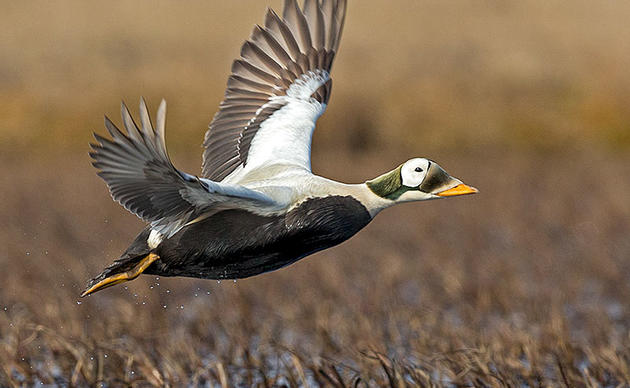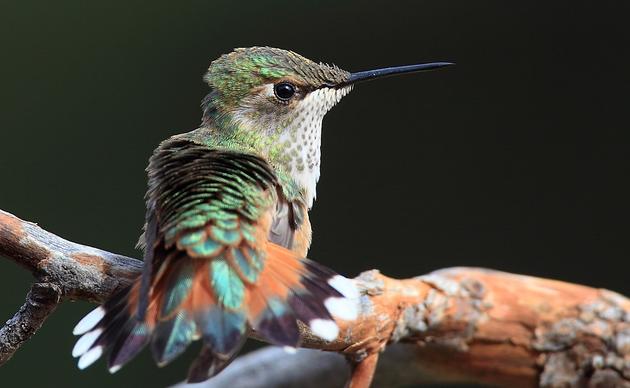When American Golden-Plovers find themselves in the North Atlantic—having moved out of Alaska’s North Slope and through Boreal forests and Arctic Canada—they know it’s time to turn south. But what makes this stopover site extra special is that it may be the last time the birds touch land until the Caribbean—or, for some, South America.
These athletes are about to begin a six to eight-day nonstop journey over the Atlantic Ocean—from, say, New England to the Bahamas or Bolivia. To gear up for this 3,000 to 3,500-mile flight, the birds must, of course, fuel up.
This is why the bird habitat of New England is vital to migration. And one New Hampshire resident—Scott Weidensaul, naturalist and author of, most recently, “A World on the Wing: The Global Odyssey of Migratory Birds”—just happens to be a migration expert. He’s here to connect the importance of habitat conservation to a successful migratory journey for the American Golden-Plover.
“Shorebirds are really one of the best examples of how delicately linked information is with habitat and distance and resources and the physiological ability of birds to traverse astounding distances,” Weidensaul says.
Weidensaul’s been involved in multiple research projects focusing on bird migration throughout the years, and across the globe, including Alaska—or ground zero for our tagged American Golden-Plovers. And while Weidensaul is a self-proclaimed "college dropout who has no academic degrees in
anything,” except honorary doctorates, including one from the university he dropped out of, this "failed biology major” really knows his stuff, especially when it comes to threats.
Threat: Habitat Loss
Weidensaul says it’s important to remember that migratory birds are not residents of any one place. Therefore, the importance of stopover and staging sites for migratory shorebirds is invaluable.
“[Migratory birds] are more critically dependent on more different kinds of habitats in more places than really almost any other organisms on the planet,” he says. "And if any single link in that chain breaks, theoretically, then that bird may go away."
And a big issue for migrating shorebirds along the northeastern coast is habitat loss by way of increasingly rising sea levels.
“That's probably the single biggest threat in this area," Weidensaul says, "is just simply running out of habitat as the oceans get higher and higher.”
Threat: Rising Sea Levels (aka Marshachusetts)
A great example is the Great Marsh—roughly 20,000 to 30,000 acres of salt marsh along the north shore of Massachusetts and the southeastern coast of New Hampshire. These extensive areas of tidal salt marsh are used by the American Golden-Plover and other species in late August and early September—the peak of fall migration for this part of New England.
But, “We've destroyed a lot of that habitat over the years and what habitat is left, even the stuff that's protected, is at increasing risk from sea level rise,” Weidensaul says. “It's not like the marsh can continue to migrate farther and farther inland as the sea levels rise because unfortunately, the backside of that portion of the uplands in many places is completely developed.”
This is bad news for migratory shorebirds and for breeding birds like Saltmarsh Sparrows, one of the most range-limited and endangered species in North America. But, Weidensaul says conservationists are trying to figure out how these critical coastal water wetlands can be allowed to migrate inland when the sea levels inevitably start to rise further.
“I think one of the most hopeful things is that there are a lot of smart people focused on this problem,” he says. There’s talk of sediment replenishment and other experiments to combat coastal erosion, but we shouldn't bank on it, because, “Nobody really knows whether any of this stuff is going to work.”
Threat: Intensifying Weather Events
To quote Weidensaul’s latest book, "… there isn't a corner of the globe, a cubic meter of the air column above it, or any moment in any migratory bird's annual cycle, that hasn't been (or soon will be) touched by the planetary fever that carbon emissions are producing.”
Tropical storms and hurricanes are coming through the Northern Atlantic at the same time of the year as migrating birds. But Weidensaul is quick to point out that many birds, especially species like Whimbrels, have been migrating through tropical storms and hurricanes for a long time. However, the intensification of even expected weather events like nor'easters exacerbates the aforementioned problems with coastal erosion.
"They're chewing away at that really critical coastal habitat. And, like I said, we're not making a whole lot more of that these days,” he says. “So what we lose is kind of permanently lost.”
Even this season, according to the New York Times, 11 named storms were formed by the end of August 2023. "Only eight other hurricane seasons in more than 100 years of record-keeping have matched that pace, according to Phil Klotzbach, a hurricane expert at Colorado State University,” the story reads.
(Even during this project, our tagged birds flew toward hurricanes Margot and Lee.)
But Weidensaul is quick to remind us of the famous hurricane story for tagged birds and those who watch them. Two Whimbrels with satellite transmitters, Goshen and Machi, emerged from the 2011 hurricane season, consisting of Hurricane Irene and other storms along their migration route, only to be legally shot on the island of Guadeloupe.
Threat: Shorebird Hunting
A good friend of Weidensaul says, and surely many of us can agree, that the lives of individual birds are fascinating. And telling their stories can interest people who might not otherwise think about migratory birds and the dangers they face.
“When you can lift away that veil of anonymity and look at one individual and see what it's doing day by day, week by week, season by season, and especially if you can do it year by year,” Wiedensaul says,” I get choked up thinking about it.”
This level of intimacy is what drew international attention to the issue of shorebird hunting in the Caribbean in 2011. The shooting of Goshen and Machi was front-page news because people had been following along. "People watched these birds fly into hurricanes and survive then boom, they're dead," Weidensaul says. But, he reminds us, this is what life and death are like for migratory birds, and there's a reason why shorebirds, along with grassland birds, are in the steepest decline in North America.
“They're really just getting hit at every point along their migration route,” he says. “Even after the American Golden-Plover leaves New England and flies long distances over the western Atlantic and makes it down to the Caribbean, there’s the risk of both legal and illegal hunting in places like the Lesser Antilles.”
And there’s another conundrum. In some places like Barbados, Weidensaul says the only good shorebird habitat left are shooting swamps. These areas are often maintained by the hunters which could mean if the hunting goes away completely, so does the habitat. Weidensaul says retiring shooting swamps can have people scrambling to find up to $75,000 a year to maintain the habitat.
“There's even been some folks who have argued, at least in general theory, that having some level of managed shorebird hunting in the Caribbean, as long as that habitat is maintained, could be an overall plus for shorebirds,” he says.
Conservationists really became aware roughly 15 years ago of the degree of shooting going on in the Caribbean. With few rules or regulations, people could have up to 120 birds in their freezers at home. But this is not to say folks in North America did not put in their time shooting shorebirds in centuries past.
According to The Cornell Lab’s All About Birds, “Market hunting in the 19th and early 20th centuries caused major declines in American Golden-Plover numbers. One estimate of a single day's kill near New Orleans was 48,000.”
And it still goes on. “We hunt Woodcock and we hunt Snipe in North America, so it's not like you can't have a sustainable, managed shorebird hunt,” Weidensaul says. “They taste good, they decoy well, they're fun to shoot. But you can't just do it on an uncontrolled basis.”
Weidensaul says folks like Brandon Watson at the Center for Conservation Biology at the College of William & Mary have issued what could be sustainable harvest levels for a variety of shorebirds. But, while things have improved overall in the Caribbean, Weidensaul says species like the American Golden-Plover, Buff-breasted Sandpiper, and Red Knot simply can’t take any kind of additive harvest.
“Many of us have realized now that one reason why so many shorebirds never really recovered from the market hunting period,” he says, “is because the hunting period never really ended in places like the Caribbean and South America.”
How to Help? Reduce Human Disturbance
So, how can the public help? One big answer is to, “Keep your dog on a leash," Weidensaul says. "That is one of the biggest problems at any coastal site, anywhere.”
Many dog owners may be unaware of how a roaming, playful, innocent animal could be wreaking major havoc on migrating birds. But that is the reality. A go-to example for Weidensaul is from a time he attended the Godwit Days festival on the Northern California coast.
It was high tide, with few places for migrating shorebirds to rest. Weidensaul was in a group of birders watching a flock of godwits who luckily found a small landing patch on shore—only they were being continuously chased by an energetic, unleashed dog. They’d fly off, circle back, land, and be chased off again in a maddening loop for the onlooking birders.
Finally, Weidensaul and friends asked the owners to leash the dog, who were at first defensive. “'We thought the birds were playing tag with the dog because he chased them and they’d come back and land in the same spot,’” Weindensaul recounts the owners saying.
"And I thought, 'Okay, in a weird way, if you don't know what to think about birds, I guess that kind of makes sense,'" he says. "To us, it seems ludicrous. But they just didn't see it that way.”
Weidensaul says, unfortunately, most people have no idea how incredibly disturbing dogs are to wildlife. Birds are extremely focused on the presence of predators, and, for shorebirds in particular, “all it takes is one dog chasing a Frisbee up and down the beach and they’ve burned off all the energy that they've been saving up feeding that day.”
But in general, recreators can have a better attitude about leashing dogs along with beach closures for nesting birds, and other efforts to reduce disturbance. “We're not a species that's very good at sharing,” Weidensaul says.
But it is possible. Weidensaul offers the Piping Plover awareness campaign along the Atlantic Coast. There’s also the National Audubon Society’s coastal stewardship program, the Atlantic Flyway Shorebird Initiative's publicly available resources on human disturbance, and countless other programs and outreach efforts.
But Hope is Not Lost
Despite all the above threats—and maybe because of people and organizations working to safeguard migratory birds and their habitat—multitudes of American Golden-Plovers still complete their southbound migration journeys despite their declining population.
In fact, Weidensaul has seen them.
Weidensaul says he has great memories from the late 90s of being on the Pampas of Argentina, with a team working on Swainson's Hawk conservation (back when Swanies were tragically being poisoned by the insecticide monocrotophos). There, he saw flocks of American Golden-Plovers on their wintering ground in the grasslands in South America.
“If I look hard enough among all of these American Golden-Plovers,” Weidensaul remembers thinking, “I will find an Eskimo Curlew.” He didn’t, but “the American Golden-Plovers were an awfully nice consolation prize.”







